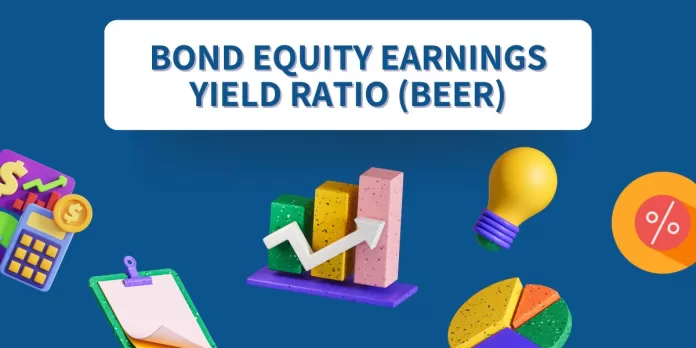Bond Equity Earnings Yield Ratio (BEER)
When you hear the term “BEER,” you might not immediately associate it with finance, but the Bond Equity Earnings Yield Ratio (BEER) is a financial metric that plays a crucial role in assessing the intricate relationship between bond yields and stock market earnings yields. It provides investors with a valuable tool to determine whether the stock market is currently overvalued or undervalued, akin to selecting the right brew to quench your thirst, depending on your taste and the prevailing conditions.
To calculate the BEER Ratio, you perform a straightforward calculation by dividing the Earnings Yield by the Bond Yield. Let’s delve a bit deeper into these components:
- Earnings Yield: This represents the earnings generated by a company relative to its stock’s market price. It is calculated by taking the earnings per share (EPS) and dividing it by the market price per share. For instance, if a company’s EPS is 10 and the market price per share is INR 200, the Earnings Yield would be 5%.
- Bond Yield: This is the yield or return generated by a bond, usually expressed as a percentage. It is calculated by taking the Coupon Yield (the annual interest payment) and dividing it by the market price of the bond, then multiplying by 100. For example, if a bond has a Coupon Yield of INR 80 and a market price of INR 1000, the Bond Yield would be 8%.
Now, let’s put these components together to calculate the BEER Ratio:
– Earnings Yield (5%) / Bond Yield (8%) = BEER Ratio of 0.625
In this scenario, a BEER Ratio below 1 indicates that the stock index is undervalued. The higher bond yield (8%) compared to the earnings yield (5%) suggests that investors may be inclined to sell their stocks and seek the stability provided by government bonds. This spread of 3% implies a bearish sentiment in the market, with investors preferring the safety of bonds over equities.
However, it’s crucial to consider the broader market dynamics. If everyone starts pouring their money into government bonds due to their higher yields, it could drive down bond yields. This, in turn, might make stock indexes more attractive, as they could potentially match or even surpass bond yields.
But what if the market doesn’t follow the expected trend according to the BEER Ratio? If bond yields remain lower than earnings per share, and investors continue to flock to bonds, it could indicate a belief that the economy is heading for a recession. In such a scenario, money markets tend to invest in treasuries or bonds backed by stable reserve currencies to safeguard their assets from potential depreciation.
Interpretation of BEER:
The Bond Equity Earnings Yield Ratio (BEER) offers valuable insights into the dynamics between bond yields and stock market earnings yields. This financial metric can be interpreted as follows:
BEER = 1: When the BEER Ratio equals 1, it suggests an equilibrium in the perceived risk levels between the bond market and the stock market. Investors see comparable levels of risk in both asset classes.
BEER < 1: A BEER Ratio below 1 indicates that equities are potentially undervalued. In this scenario, it might be considered a favorable time for investors to increase their allocation to stocks, as they are deemed more attractive compared to bonds.
BEER > 1: Conversely, when the BEER Ratio surpasses 1, it signifies that equities are possibly overvalued relative to fixed income investments like bonds. Investors may contemplate reducing their exposure to stocks in favor of bonds or other assets.
Limitations of BEER:
Limited Predictive Value: One notable limitation of the BEER Ratio is its relatively limited predictive value. Research based on historical yields in the Treasury and stock markets suggests that BEER may not be a reliable predictor of future trends. In other words, it might not consistently forecast whether stocks will outperform bonds or vice versa.
Fundamental Differences: Another limitation stems from the fundamental differences between stocks and bonds. Government bonds come with contractual guarantees to repay principal and interest, whereas stocks provide no such guarantees. The BEER Ratio calculation does not account for these distinctions, potentially oversimplifying the comparison.
Read: Corporate Actions in Share Market
Earnings and Dividends Variability: Stock prices are influenced by a company’s earnings and dividend payments, both of which can be highly variable and unpredictable. In contrast, bond payments are typically more stable and predictable. BEER does not consider these factors when comparing the two asset classes.
Now, let’s provide a real-world example to demonstrate the application of the BEER Ratio:
Example:
During significant market events like the Demonetization period and the Taper Tantrum in 2012-13, the BEER Ratio for a particular stock index, such as the Nifty, might have slipped to 1.1. In this scenario, the earnings yield of stocks was slightly higher than the yield on a 10-year Treasury bond. Such instances can be pivotal for investors.
Historically, when the earnings yield has surpassed bond yields, similar situations were observed during fiscal years 2002-03 and 2008-09. These episodes were followed by outsized returns in both cases. This historical context highlights the potential significance of the BEER Ratio in guiding investment decisions.
In conclusion, the Bond Equity Earnings Yield Ratio (BEER) is a tool that allows investors to gauge the relative appeal of equities compared to bonds, much like choosing between different types of beers depending on your preferences. While BEER has its limitations, such as its inability to predict future trends and the fundamental differences between stocks and bonds, it remains a significant indicator, especially in situations where equity valuations are low, and government bond yields are rising. Therefore, investors should raise a glass to informed decision-making and let the BEER Ratio guide their investment choices. Cheers to financial wisdom!


